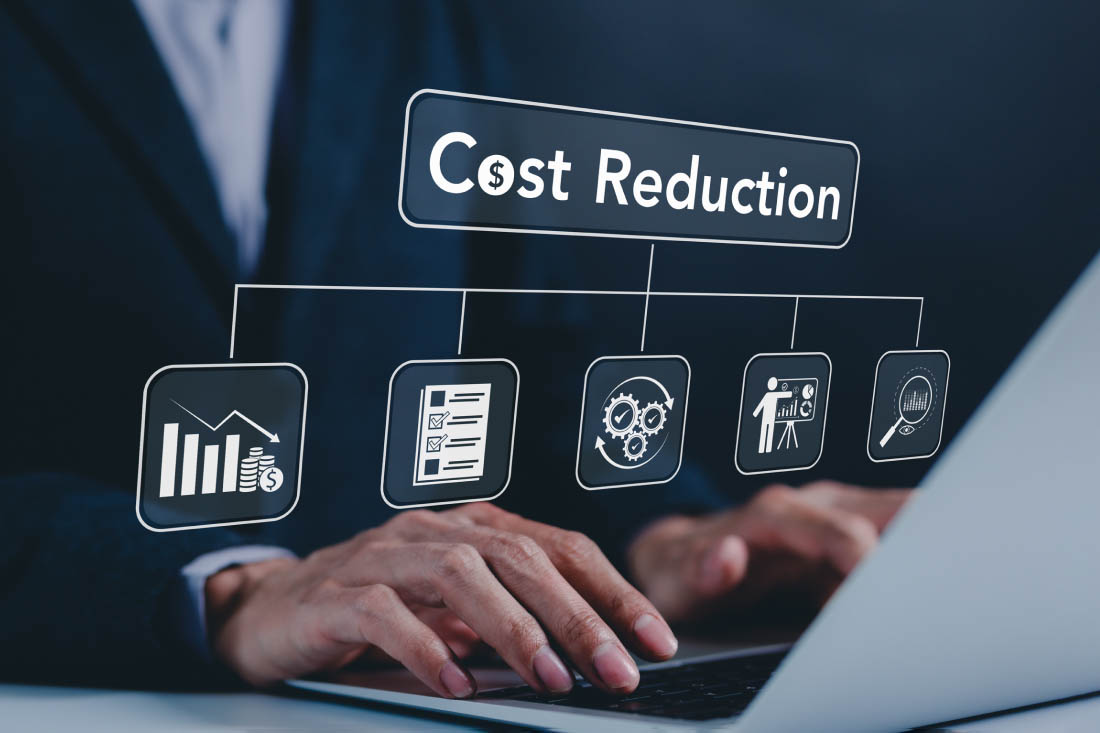While it’s important to answer the question “What is my organization’s productivity?”, it is far more important to address the question “How can we sustain our productivity improvements?”
In this article, I will unpack the complexity of that question—and the different information you’ll need to collect prior to starting on your productivity improvement plan. Next, I will focus on helping you prioritize actions and responses so that you can improve productivity quickly, while also ensuring those improvements last over time. And finally, we will address the mindset shift necessary for lasting change— one that moves away from the one-time productivity fix and toward the ongoing productivity journey; because continuous productivity improvement is the foundation to keeping your business relevant, your workforce engaged, and inspiring the innovation needed to lead in the modern marketplace.
The 5 Questions You Need to Ask about Current Productivity
When asking the question, “How can I improve current productivity so that our workforce can be productive in the future?”, you are really seeking to answer this series of questions:
- What is my current workplace productivity?
- What is getting in its way?
- What do I need to do to remove barriers?
- What additional support can I provide?
- And the original question: How do I go about improving it?
Finding Your Productivity Baseline
To begin, you need to understand your current level of productivity. Without having a baseline of those metrics associated with productivity, it becomes very difficult to answer any other questions about your productivity. Because productivity is a function of both input and output, you will need to understand the levels at which your business is currently producing output, and managing inputs, typically categorized by your organization’s people, process, and technology.
Outputs are the tangible metrics we can see, for example, how many cars produced by an automobile manufacturer or the number of burgers sold at a restaurant. The inputs, which are often intangible and harder to see, consist of a series of behaviors that ultimately generate the levels of production achieved within your business. While harder to see, they are undoubtedly the most important components of your productivity metrics.
If your inputs fall short, your outputs will as well. By using a workforce productivity monitoring app like ActivTrak to evaluate inputs, leaders are able to answer Question 1: What is my current workplace productivity? Productivity tools are excellent, non-disruptive means to garner insight into productive behaviors. Measuring inputs is done through observing the behaviors and activity in the workplace.
For example, in below in Figure 1: ActivTrak Productivity Report, you can see an overview of a team’s productive time (green) vs. unproductive time (yellow) to understand the current baseline and the previous weeks’ productivity measurement. This insight highlights key areas where a business may focus its productivity improvement efforts.
Figure 1: ActivTrak Productivity Report
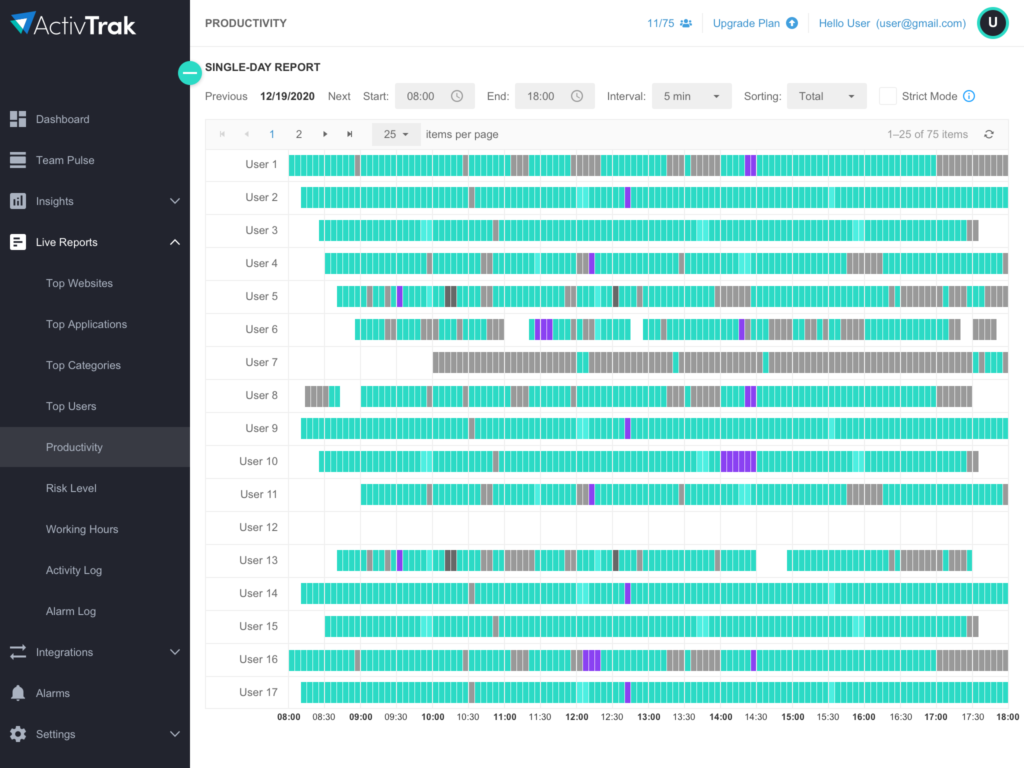
Identifying and Resolving Productivity Barriers
Through studying the current state of your organization’s productivity, you can pinpoint answers to Question 2: What is getting in its way? In the visuals below, ActivTrak draws a leader’s attention to high burnout risk employees ( Figure 2a: ActivConnect Burnout Report ) and excessive use of collaboration tools (Figure 2b: ActivConnect Focus Report ). These two reports guide managers in the direction of answering Questions 3 & 4; understanding what actions and responses may be necessary to remove barriers and provide additional support. In this case, that could mean intervening and encouraging shorter work hours or pushing out deadlines to allow for greater work-life balance. And, in the case of collaboration, this could mean encouraging people managers to reduce the use of messaging tools and instead replace them with quick sync meetings in order for the team to be more efficient with their time.
Figure 2a: ActivConnect Burnout Report
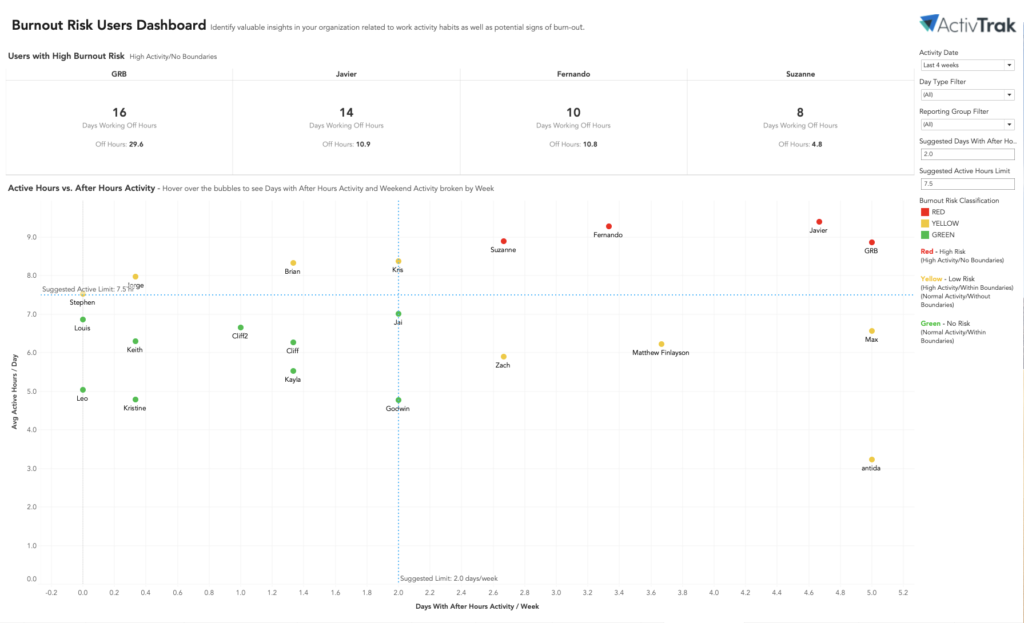
Figure 2b: ActivConnect Focus Report
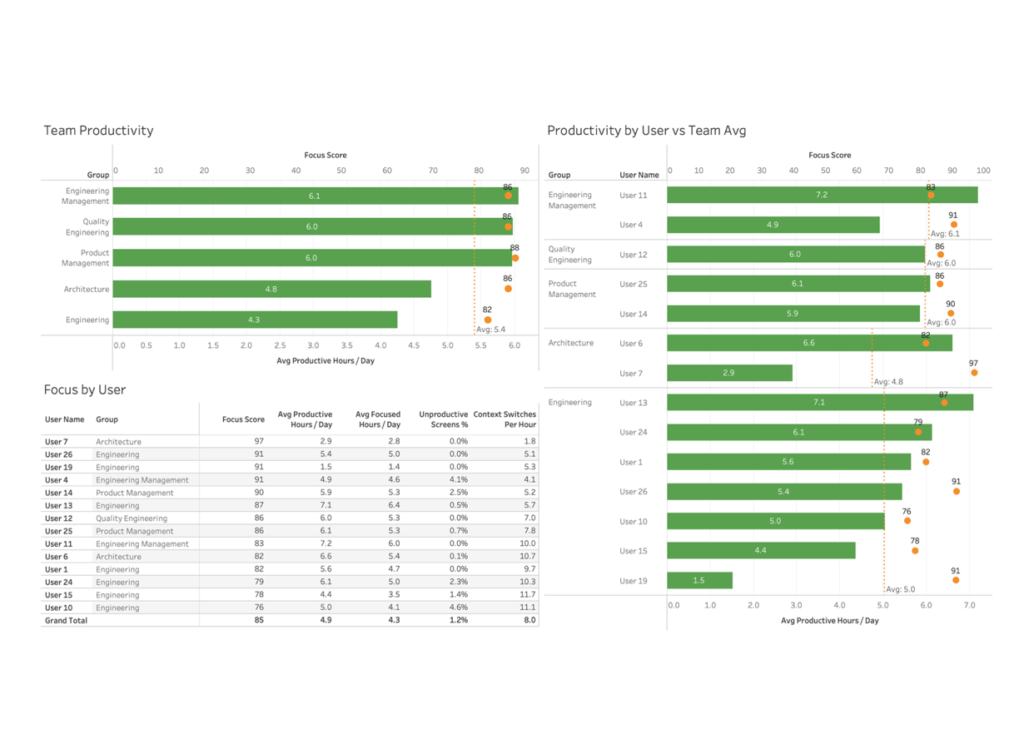
We are only in a position to address Question 5: How do I go about improving productivity, the basis of the original question, once we have collected the critical insights from questions 1-4. Organizations can begin to understand how to go about improving productivity when they understand their current productivity levels, know what barriers exist, and acknowledge what support is needed. Improving productivity is a concept that requires thoughtful, progressive, and routine leadership actions that enable the workforce, support the processes, and encourage the technology adoption. Ultimately, productivity is improved when workforce behaviors are in support of a more productive environment. The actions and responses required by management should be focused more on empowering productive behaviors and less on demanding greater output.
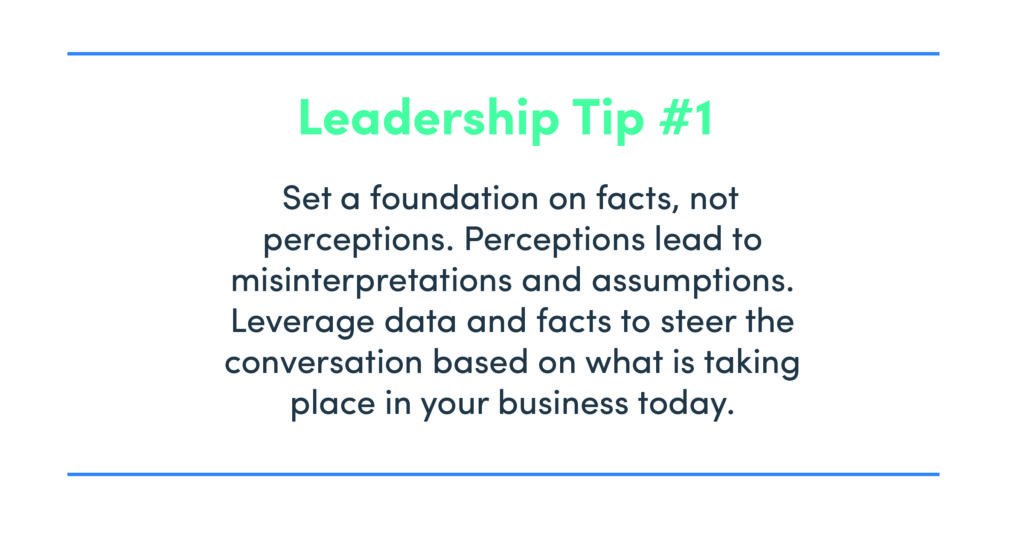
Leadership Alignment: Prioritizing Actions & Responses
Brainstorming and choosing the right actions and responses to improve an organization’s productivity begins with leadership alignment. Leveraging data insights that uncover productivity barriers and opportunities for improvement provides factual evidence from which the group can align. The data reveals to leadership not only that the gaps exist, but also their level of magnitude and organizational pervasiveness. Establishing leadership alignment on productivity barriers and necessary support allows the team to quickly move into response prioritization.
With your leadership team, begin by brainstorming what barriers and opportunities exist across the key enabler areas.
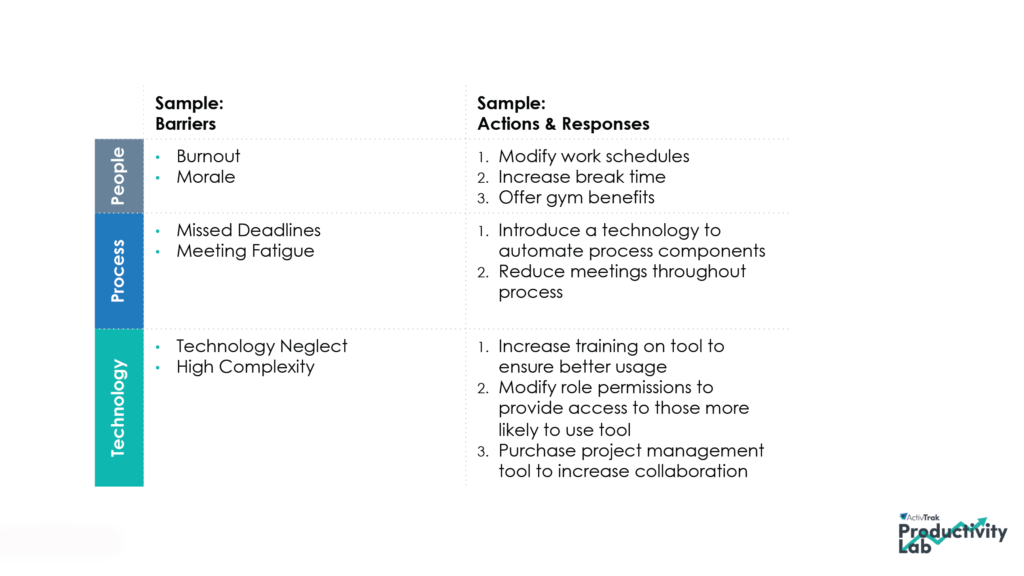
Like most effective brainstorming sessions, encourage your team to actively participate, think outside the box, and develop new ideas without the limitations that currently face the organization. While considering a broad range of solutions, both cost and impact should come second to capturing all the possible responses. Understand that some solutions may actually solve multiple productivity barriers and business issues.
Select the Most Practical Solutions for your Organization
Once your team amasses enough ideas through brainstorming, the next step is to evaluate each potential solution.. Using a Cost/Impact matrix, such as the one shown below, ask your leaders to place the various solutions on the matrix to help evaluate which solutions are viable in the immediate and long term. Encourage your leaders to consider the following:
- How big of an impact will the solution have on their team’s and the entire organizations’ productivity?
- What’s the associated cost (time and money) for the solution?
- Which solutions could solve for more than one barrier or issue?
- Which solutions will resonate the most with employees today?
- What actions could help us immediately establish trust and buy-in, making changes easier to implement?
Figure 3: Solution Set Matrix
Engage in conversations amongst the team. “Reduce Meetings” may be a good solution in theory, but with the input of other team members, you may decide that due to strong need to share information across a wide range of groups and collect input, it is actually not a sound solution. Notice the red highlights above in Figure 3: Solution Set Matrix, certain solutions address multiple barriers. Prepare a final response list with your team that they feel confident about implementing. As the leader, commit to funding and leading through the change necessary to make the solutions work. It’s now time to make a plan.
Developing a Sustainable Productivity Improvement Plan
Creating your productivity improvement plan requires committed leadership, transparent communication, and thoughtful change management. Improving productivity starts with taking action to understand and solve for the barriers standing in the way. Positive productivity transformation is realized when workplace behaviors, interactions, and processes change.
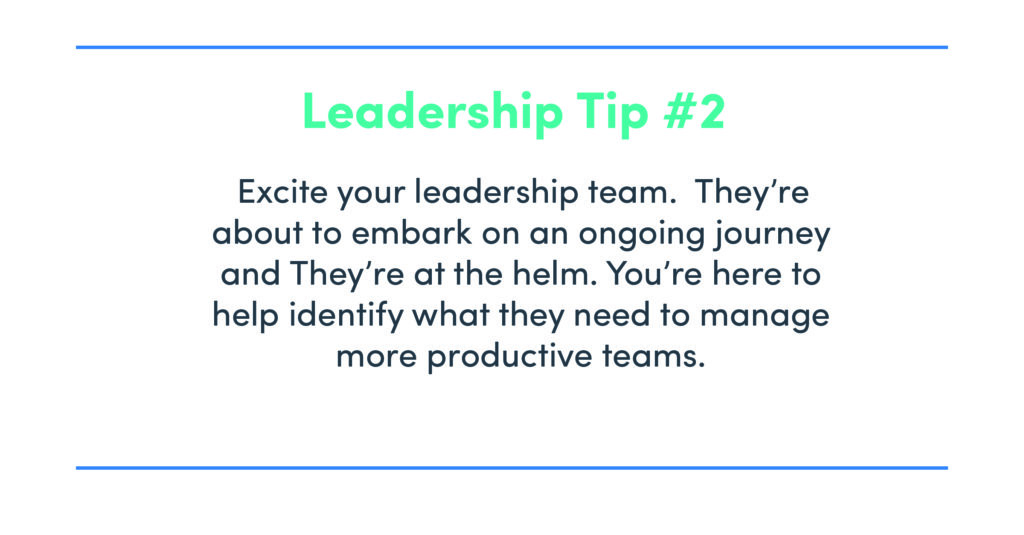
Plan Element: Make a Leadership Commitment
Be sure to select actions and responses that your organization cares most about and will welcome as an improvement to their daily approach to work. Seek trust from your employees by sharing with them what you’ve learned through their feedback and seen in your workforce productivity data as a foundation for why you and other leaders have chosen to take action. Commit to positive and sustainable change; reinforcing that if solutions don’t work right away, you’re open to discussions and feedback on how to improve existing, or introduce alternative, measures. Your action plan must start with deliberate leadership commitments. Quick steps to move into action include:
- Host a meeting with your direct reports to ensure leadership alignment across your entire team. Address their feedback and questions to establish trust and teamwork.
- Host a company-wide kick-off meeting to make your commitments to the organization known while establishing accountability.
Plan Element: Communicate Often and with a Purpose
Effective communications stem from a leadership team that is eager to communicate with the workforce openly and often. Your communications should be multi-channeled; leveraging email, town hall-style meetings (either hosted in-person or virtually), and informal interactions to reinforce key messages around productivity improvement, transparency, and feedback. Focus on sharing with your employees what changes are coming, the planned timelines associated with each change, and their intended impact. Quick steps to move into action include:
- Create a communications plan so that your initial company-wide communication is followed up with consistent updates.
- Ensure communications are rooted in facts by leveraging actual workforce productivity data along with employee feedback as the basis for your actions.
- Establish the feedback loop with focus groups, manager touch points, and 1×1 meetings so that your communication strategy is two-way, rather than one-dimensional.
Plan Element: Change Management
Change Management is often thought of as the integration of both effective leadership and timely communication. An additional key component to change management and thus, successful productivity improvement, is a sequential implementation plan. For most organizations, a series of abrupt actions and responses can be disruptive and overwhelming. Particularly when training is required, employees are likely to benefit from smaller, spread-out changes that allow them time to adjust. Effective change management, which includes both ownership and status tracking, will heavily contribute to your improved productivity. Quick steps to move into action include:
- Understand the impact of your actions and responses on the business. Conduct a rapid change impact assessment, as seen below, to understand which actions will cause distractions, disruptions, or resistance so that you can incorporate this information into your sequential plan (note: you don’t want to avoid rolling out the most disruptive solutions at the time). In the example below, the change impact assessment highlights the different actions an organization may take and the change impact they may have on each team. Red denotes disruptive change impact, while green represents minimal to no disruption.
Figure 4: Sample: Rapid Change Impact Assessment
Takeaways from this Rapid Change Impact Assessment:
- Push Start Day to 9 am should be Action 1 in the plan – it does not cause disruption and will likely be a welcomed improvement across the entire organization.
- While No Meeting Wednesdays & 2 Breaks/Day have varying levels of impact across the organization, opt for 2 Breaks/Day because the disruption will be equal across the business. Thus, the workforce can adapt together at the same pace.
- Once establishing organization-wide solutions, shift to No Meeting Wednesdays. Communicate specifically to the Product Team and Sales Team that they will feel the greatest impact. Incorporate feedback sessions with them to understand what support they may need along the way.
- Finally, you can implement Switch Technology Solutions – likely the longest and most expensive productivity response to implement. Before doing so, incorporate a robust communications approach. Highlight the progress made so far and excite the organization with data that shows the productivity improvement throughout the last months. Given that this is your greatest investment among your actions and responses, you will have far greater chances of success after rolling out the previous solutions and proving their positive impact.
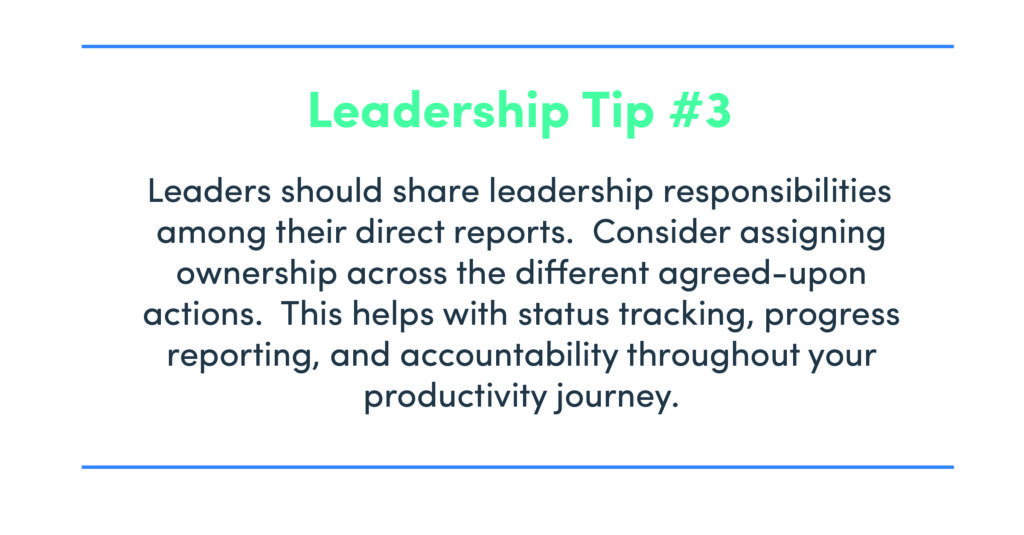
Figure 5: Sample: Action & Response Sequenced Plan
Making Lasting Productivity Changes
Improving workplace productivity should be a proactive pursuit; not a reactive one. For when you are operating on a reactive productivity strategy, you accept that that productivity is routinely being lost, keeping you on a constant hunt for solutions. Through routine measurement, leadership & employee buy-in, methodical actions toward improvement, and most importantly, a sound implementation plan, your business can unlock its productivity potential. It’s time to shift your mindset by seeing productivity as a lasting key to success. By making sustainable productivity improvements, your business can gain a competitive advantage in the marketplace.
Want more productivity resources?
- The ActivTrak Productivity Lab
- From Data to Decisions: Workforce Productivity 101
- Productivity 101 Webcast: How to Define, Measure, and Improve Productivity in the Workplace
- Report: Using Productivity Analytics to Measure and Improve Performance and Engagement
About ActivTrak and The Productivity Lab
ActivTrak helps companies unlock productivity potential. Our award-winning workforce productivity and analytics software provides expert insights that empower people, optimize processes, and maximize technology. With data sourced from more than 8,000 customers and 250,000 users, ActivTrak’s Productivity Lab is a global center for ground-breaking workforce productivity research and expertise that helps companies embrace and embody the future of work. Get a free account, no credit card required.




